 |
 |
 |
| |
Tenofovir Alafenamide for Pregnant Chinese Women with Active
Chronic Hepatitis B: A Multicenter Prospective Study
|
| |
| |
Download the PDF here
Dec 10 2021
Here, we report the safety and effectiveness profiles in pregnant women with active CHB and their infants when TAF is administered throughout gestation or beginning in the early phase of pregnancy.
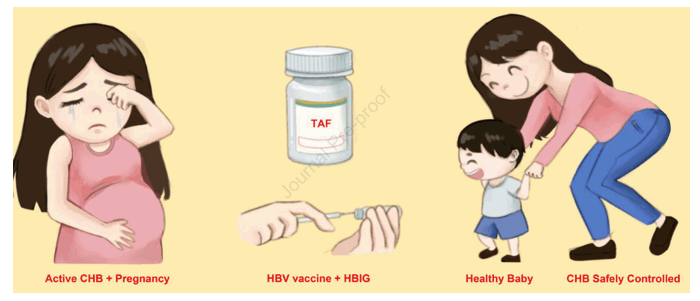
This multicenter prospective study was conducted in 11 public referral hospitals in China. All chronic HBV-infected pregnant women and women contemplating pregnancy were assessed for eligibility from January 1, 2019, to March 31, 2020. Pregnant women with active CHB who were treated with TAF or tenofovir disoproxil fumarate (TDF) were enrolled, and those pregnant women and their infants were followed until at least postpartum months 6 and 7, respectively. The final follow-up date was September 30, 2021.
At the 7-month visit for infants, no infant was positive for HBsAg, i.e., the MTCT rate was 0%. Additionally, 101 (99.0%) and 104 (100%) infants were positive for anti-HBs, with mean levels of 404.9 (± 285.3) and 411.0 (± 253.8) mIU/ml in the TAF and TDF
groups, respectively. Notably, the abovementioned anti-HBs levels may be underestimated because 7 and 6 infants' anti-HBs levels were reported as "> 1000 mIU/ml" in the TAF and TDF groups, respectively, and were calculated as 1000 mIU/ml.
Although infants born to pregnant women with chronic HBV infection share the same immunization prophylaxis procedures, pregnant women who had active CHB require longer or even indefinite durations of antiviral treatment, and pregnant women with inactive chronic HBV infection only need definite short-term antiviral prophylaxis. Therefore, safety is the priority for pregnant women with active CHB who require long-term therapy. As shown in the present study, a mean of two years of TAF treatment is well tolerated with no major safety concerns and presents favorable effectiveness for pregnant women with active CHB who initiated TAF before or beginning in the early
phase of pregnancy. Additionally, no congenital defects or malformations were observed in live infants at birth after approximately full gestational TAF exposure. Unsurprisingly, the MTCT rate was 0% in combination with standard HBV immunoprophylaxis for infants.
Regarding the effectiveness concerns in this study, unexpectedly, two pregnant women with virological breakthrough both had excellent TAF compliance (Supplementary Table 4). Based on the extensive discussion by our team, we decided to continue TAF monotherapy for the pregnant woman with an "entecavir switch to TAF". Fortunately and even confusingly, her HBV DNA decreased to undetectable
levels approximately 4 months later and thereafter. Additionally, we deliberatively decided to add lamivudine to TAF because the pregnant women who switched from the entecavir and TDF combination to TAF due to her previously poor response to either entecavir or TDF monotherapy. Fortunately, and even expectedly, her HBV DNA level decreased to undetectable levels approximately 3 months later and thereafter. These management strategies may be used in a similar situation in the future. Although we did not determine the cause of virological breakthroughs, detection errors for HBV DNA levels cannot be completely excluded in the entecavir-treated pregnant woman,
and previous poor response experiences and switchover to TAF monotherapy may be the cause in another pregnant woman.
As an updated version of TDF with more potentially favorable safety profiles, TAF has been licensed for the treatment of CHB in China since December 2018 and has been recommended as a first-line antiviral agent by the main CHB guidelines.
In conclusion, the current study indicates that TAF administered throughout or beginning in early pregnancy to pregnant women with active CHB was generally safe and effective for both pregnant women and infants, which provides relevant evidence to support the use of TAF in pregnant women with active CHB as an alternative option. Notably, in combination with the previous three studies involving short-term TAF treatment of pregnant women with inactive chronic HBV infection,7,17,18 this prospective study can be viewed as another key piece of the puzzle for "TAF use in HBV-infected pregnant women" suggested by the WHO.1 Nevertheless, future larger-scale studies are needed to validate this conclusion.
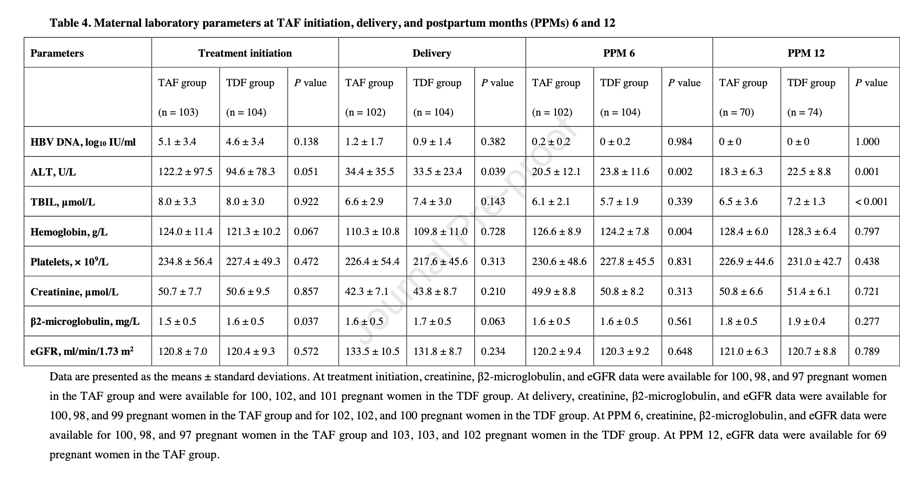
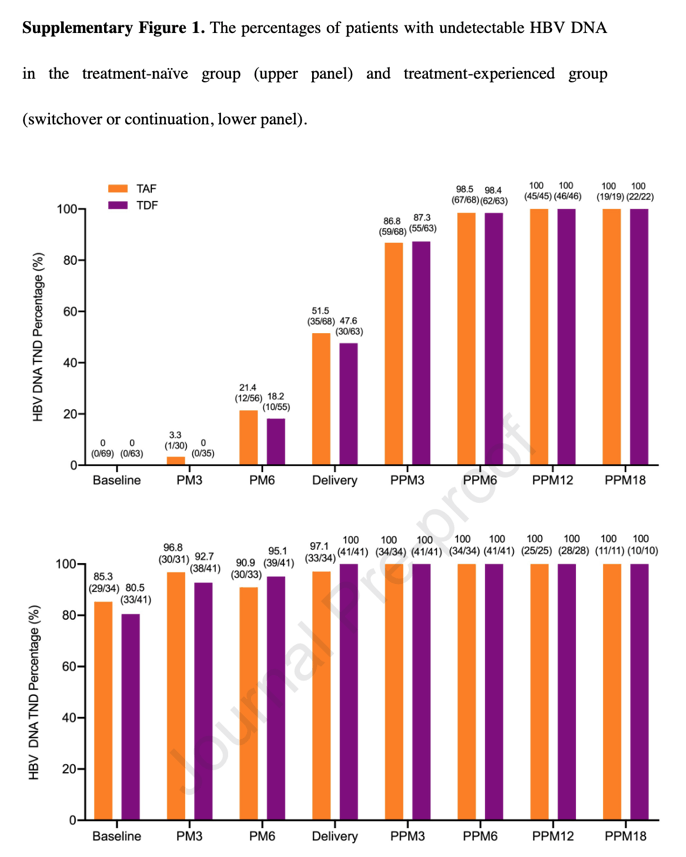
Tenofovir Alafenamide for Pregnant Chinese Women with Active Chronic Hepatitis B: A Multicenter Prospective Study
Clinical Gastroenterology and Hepatology Dec 10 2021
Qing-Lei Zeng, Hong-Xu Zhang, Ji-Yuan Zhang, Shuo Huang, Wei-Zhe Li, Guang-Ming Li, Ya-Jie Pan, Ying-Hua Feng, Zhi-Qin Li, Guo-Fan Zhang, Jiang-Hai Xu, Wan-Bao Lin, Guang-Hua Xu, Na Liu, Guo-Qiang Zhang, Guo-Tao Li, Wei Li, Yan-Li Zeng, Ning Song, Meng Wang, Da-Wei Zhang, Zhi-Min Chen, Guang-Lin Cui, Juan Li, Jun Lv, Yan-Min Liu, Hong-Xia Liang, Chang-Yu Sun, Yi-Hua Zhou, Zu-Jiang Yu, Fu-Sheng Wang
ABSTRACT
BACKGROUND & AIMS
Data on long-term tenofovir alafenamide (TAF) therapy for pregnant women with active chronic hepatitis B (CHB, immune clearance and reactivation phases [currently and previously diagnosed]) and their infants are lacking.
METHODS
Pregnant women with active CHB treated with TAF and tenofovir disoproxil fumarate (TDF) were enrolled in this multicenter prospective study, and infants received immunoprophylaxis. The primary outcomes were rates of adverse (safety) events in pregnant women and defects in infants and fetuses. The secondary outcomes were virological responses in pregnant women, infants' safety, hepatitis B surface antigen (HBsAg) status, and growth conditions.
RESULTS
One hundred three and 104 pregnant women were enrolled, and 102 and 104 infants were born in the TAF and TDF groups, respectively.
In the TAF group, the mean age, gestational age, alanine aminotransferase level, and viral loads at treatment initiation were 29.3 years, 1.3 weeks, 122.2 U/L, and 5.1 log10 IU/ml, respectively.
TAF was well tolerated, and the most common adverse event was nausea (29.1%) during a mean of two years of treatment. Notably, 1 (1.0%) TAF-treated pregnant woman underwent induced abortion due to noncausal fetal cleft lip and palate.
No infants in either group had birth defects. In the TAF group, the hepatitis B e antigen seroconversion rate was 20.7% at postpartum month 6, infants had normal growth parameters, and no infants were positive for HBsAg at 7 months. The TDF group had comparable safety and effectiveness profiles.
CONCLUSIONS
TAF administered throughout or beginning in early pregnancy is generally safe and effective for pregnant women with active CHB and their infants.
Results
Participants
A total of 2688 pregnant women or women contemplating pregnancy with chronic HBV infection were assessed for eligibility, and 103 and 104 pregnant women with active CHB were enrolled for treatment with TAF and TDF, respectively (Figure 1). Notably, participants in each group were further divided into two subgroups at TAF initiation (Table 1), i.e., the treatment-naïve subgroup and the treatment-experiencing subgroup (switched to or continued TAF or TDF monotherapy). The mean time points of treatment initiation were 1.3 (± 14.6) and 1.0 (± 12.3) weeks referring to the first day of pregnancy (LMP), and 53 (51.5%) and 50 (48.1%) of these patients in the TAF and TDF groups started treatment before pregnancy, respectively. At treatment baseline, 74 (71.8%) and 71 (68.3%) pregnant women had detectable HBV DNA levels, 82 (79.6%) and 88 (84.6%) pregnant women were HBeAg-positive, and 72 (69.9%) and 67 (64.4%) pregnant women had elevated ALT levels in the TAF and TDF groups, respectively (Table 1). In total, 102 and 103 live newborns were born to women in the TAF and TDF groups, respectively (Table 2). Based on the pregnant women's personal preferences, 71 (69.6%)and 74 (71.2%) infants received breast milk in the TAF and TDF groups, respectively.
Safety of Pregnant Women
The mean TAF treatment durations were 96.1 (± 24.4) and 98.7 (± 21.9) weeks in the TAF and TDF groups. TAF and TDF were both well tolerated in the pregnant women, and no pregnant woman discontinued therapy because of adverse events (Table 3). The most common adverse events and complications were nausea (29.1% [TAF] vs. 31.7% [TDF]) and premature rupture of membranes (12.6% [TAF] vs. 13.5% [TDF]) in both groups, and no significant differences were observed in the occurrences of adverse events and complications between the two groups. Notably, 1 (1.0%) pregnant woman exposed to agricultural chemicals during early pregnancy who initiated TAF from 12 weeks plus 2 days of gestation underwent induced abortion at 23 weeks plus 4 days of pregnancy due to the diagnosis of cleft lip and palate for the fetus at 22 weeks of gestation.
In terms of laboratory abnormalities (Table 4), the most common was anemia in both groups, ranging from 10.7% to 52.9% of pregnant women during pregnancy, and 1.9% to 20.2% of them were diagnosed with moderate anemia, which was defined as a hemoglobin concentration ranging from 70 to 99 g/L.12 However, the hemoglobin levels recovered to normal in almost all pregnant women after delivery. Additionally, the levels of platelets, total bilirubin, creatinine, β2-microglobulin, and eGFR were consistently normal, and no significant fluctuations were observed between the two groups (Table 4 and Supplementary Tables 1 and 2).
Safety of Infants or Fetuses
The prenatal TAF exposure duration for the fetuses was 32.1 (± 9.4) and 33.8 (± 8.3) weeks in the TAF and TDF groups, respectively(Table 2). No infant had an Apgar score of less than 8 at 1 minute of birth. No congenital defects or malformations were observed at birth, with the exception of the one fetus described above that underwent induced abortion due to cleft lip and palate (Supplementary Table 3). The most common abnormal condition was prolonged (neonatal) jaundice, which was defined as neonatal jaundice lasting more than 2 weeks in term infants and more than 3 weeks in preterm infants,13 and it occurred in 13 (12.7%) and 14 (13.4%) infants in the TAF and TDF groups, respectively. Prolonged jaundice either spontaneously resolved or was cured by phototherapy alone in these infants before 2 months of age.
Other abnormal conditions that occurred in one or more infants included fever (13/102 [12.7%] vs. 13/104 [12.5%]), cough (10/102 [9.8%] vs. 9/104 [8.7%]), vomiting (9/102 [8.8%] vs. 9/104 [8.7%]), skin rash (6/102 [5.9%] vs. 5/104 [4.8%]), diarrhea (4/102 [3.9%] vs. 5/104[4.8%]), hearing impairment (1/102 [1.0%]) vs. 0/104 [0%], and cutaneous hemangioma (1/102 [1.0%] vs. 0/104 [0%]; on the left arm, size: 15 × 25 mm) in TAF and TDF groups, respectively. The infant diagnosed with hearing impairment at 1 week was then identified as having a conductive hearing impairment due to secretory otitis media at 3 months, but the condition eventually recovered spontaneously at 6 months; additionally, the other infant who was reported with cutaneous hemangioma at 4 weeks of age had been cured at 1 year (Supplementary Table 3). Notably, the infants' physical development at birth, 7 months, 12 months, and 18 months were comparable to the China national and WHO standards for children's growth (Table 5); at some time points, the growth parameters may be even better due
to the possibly better nutrition for the infants currently. However, no significant differences in infants' growth parameters were observed between the TAF and TDF groups (Table 5).
On-time Rate of Immunoprophylaxis
Among the 206 newborns, the on-time conditions and the first doses of immunoprophylaxis are presented in Table 2. Regarding theadministration of the second and third doses of HBV vaccine, 86 (84.3%) and 89 (85.6%) infants were injected on time, and the remaining 16 (15.7%) and 15 (14.4%) infants were delayed within 1-3 weeks because of prolonged neonatal jaundice, pregnant women's personal preferences, vaccination station reasons, or traffic influenced by coronavirus disease 2019 described in our previous studies.7,14
Effectiveness in Pregnant Women
The mean serum HBV DNA levels gradually decreased to 1.2 (± 1.7) and 0.9 (± 1.4) log10 IU/ml at delivery and 0.2 (± 0.2) and 0 (± 0.2) log10 IU/ml at postpartum month 6 in the TAF and TDF groups, respectively (Table 4 and Supplementary Tables 1 and 2). The percentages of women with undetectable HBV DNA, ALT normalization, and HBeAg seroconversion gradually increased with the continuation of treatment (Supplementary Figures 1, 2, and 3); however, no significant differences were observed between the TAF and TDF groups (all P > 0.05). Additionally, no pregnant woman in either group exhibited HBsAg loss during treatment. Notably, virological breakthrough occurred in 2 (2.0%) TAF-treated pregnant women after approximately 6 months of switchover from previous entecavir or entecavir/TDF regimens to TAF therapy, and Supplementary Table 4 presents the details.
Effectiveness in Infants
At the 7-month visit for infants, no infant was positive for HBsAg, i.e., the MTCT rate was 0%. Additionally, 101 (99.0%) and 104 (100%) infants were positive for anti-HBs, with mean levels of 404.9 (± 285.3) and 411.0 (± 253.8) mIU/ml in the TAF and TDF
groups, respectively. Notably, the abovementioned anti-HBs levels may be underestimated because 7 and 6 infants' anti-HBs levels were reported as "> 1000 mIU/ml" in the TAF and TDF groups, respectively, and were calculated as 1000 mIU/ml.
DISCUSSION
Although infants born to pregnant women with chronic HBV infection share the same immunization prophylaxis procedures, pregnant women who had active CHB require longer or even indefinite durations of antiviral treatment, and pregnant women with inactive chronic HBV infection only need definite short-term antiviral prophylaxis. Therefore, safety is the priority for pregnant women with active CHB who require long-term therapy. As shown in the present study, a mean of two years of TAF treatment is well tolerated with no major safety concerns and presents favorable effectiveness for pregnant women with active CHB who initiated TAF before or beginning in the early
phase of pregnancy. Additionally, no congenital defects or malformations were observed in live infants at birth after approximately full gestational TAF exposure. Unsurprisingly, the MTCT rate was 0% in combination with standard HBV immunoprophylaxis for infants.
Although infants born to pregnant women with chronic HBV infection share the same immunization prophylaxis procedures, pregnant women who had active CHB require longer or even indefinite durations of antiviral treatment, and pregnant women with inactive chronic HBV infection only need definite short-term antiviral prophylaxis. Therefore, safety is the priority for pregnant women with active CHB who require long-term therapy. As shown in the present study, a mean of two years of TAF treatment is well tolerated with no major safety concerns and presents favorable effectiveness for pregnant women with active CHB who initiated TAF before or beginning in the early
phase of pregnancy. Additionally, no congenital defects or malformations were observed in live infants at birth after approximately full gestational TAF exposure. Unsurprisingly, the MTCT rate was 0% in combination with standard HBV immunoprophylaxis for infants.
As an updated version of TDF with more potentially favorable safety profiles, TAF has been licensed for the treatment of CHB in China since December 2018 and has been recommended as a first-line antiviral agent by the main CHB guidelines.5,15,16 Recently, TAF costs approximately 80 US dollars per bottle (30 tablets) before 50-90% reimbursement and has increasingly been used as the "first-line of three first-line drugs" for CHB in real-life clinical practice in China. Additionally, the drug label of TAF clearly indicates its usage during pregnancy in China.17
In July 2020, the WHO Guidelines for the Prevention of HBV MTCT suggested the "Evaluation of TAF" in the Research Gap.1 To date, three recent studies have documented the favorable safety and effectiveness profiles of short-term TAF treatment for inactive chronic HBV-infected pregnant women.7,17,18 However, long-term safety and effectiveness data of TAF administration during early or even before pregnancy for pregnant women with active CHB are lacking worldwide. To the best of our knowledge, this study is the first to assess TAF use for therapeutic purposes in pregnant women with active CHB, which differs from our and three other previous studies investigating TAF use for prophylactic purposes to mainly prevent HBV MTCT.7,17,18 Notably, the present study not only included treatment-naïve pregnant women with active CHB but also included another common type of pregnant women, i.e., women who were previously diagnosed with active CHB and treated with nonclass B antiviral drugs defined by the US Food and Drug Administration before 2015 (such as entecavir) and intended for pregnancy, which increases the representativeness of the study.
Regarding safety concerns in this study, TAF-treated pregnant women experienced nonspecific adverse events and complicationssimilar to the TDF groups, with the exception of a pregnant woman who suffered induced abortion due to fetal cleft lip and palate. Cleft lip and palate arise in approximately 1.7 per 1000 liveborn babies, and environmental risk factors might be important for theirdevelopment.19,20 Maternal exposure to smoke during pregnancy has been consistently associated with an increased risk of both cleft lip with or without cleft palate and isolated cleft palate, with a population-attributable risk as high as 20%.19 Additionally, maternal exposure to agricultural chemicals has been associated with cleft lip and palate.19 Notably, this pregnant woman was exposed to smoke passively for years and to agricultural chemicals during the first month of gestation. Most importantly, the developmental processes of the lip and palate are completed by 6-10 weeks of embryogenesis,19,20 and this pregnant woman initiated TAF after 12 weeks of gestation. Therefore, we strongly doubt and almost certainly excluded a role for TAF in the development of cleft lip and palate in this fetus. Additionally, we also excluded a role for TAF in the development of hearing impairment because of the subsequent diagnosis of secretoryotitis media and eventual spontaneous recovery. Unfortunately, we were unable to determine the role of TAF in infantile hemangioma, which may be induced by intrinsic factors (such as angiogenic and vasculogenic factors) and extrinsic factors (including tissue hypoxia and developmental field disturbances),21 and future large-scale studies may resolve this confusion. Finally, although more than two-thirds of infants were breastfed during continuous TAF treatment of their mothers, the infants' growth parameters were normal at 7 months, 12 months, and 18 months, indicating that even potential TAF exposure through breastfeeding may not increase the risk of abnormal infant growth.
Regarding the effectiveness concerns in this study, unexpectedly, two pregnant women with virological breakthrough both had excellent TAF compliance (Supplementary Table 4). Based on the extensive discussion by our team, we decided to continue TAF monotherapy for the pregnant woman with an "entecavir switch to TAF". Fortunately and even confusingly, her HBV DNA decreased to undetectable
levels approximately 4 months later and thereafter. Additionally, we deliberatively decided to add lamivudine to TAF because the pregnant women who switched from the entecavir and TDF combination to TAF due to her previously poor response to either entecavir or TDF monotherapy. Fortunately, and even expectedly, her HBV DNA level decreased to undetectable levels approximately 3 months later and thereafter. These management strategies may be used in a similar situation in the future. Although we did not determine the cause of virological breakthroughs, detection errors for HBV DNA levels cannot be completely excluded in the entecavir-treated pregnant woman,
and previous poor response experiences and switchover to TAF monotherapy may be the cause in another pregnant woman.
A limitation exists in this study, i.e., adverse events with a frequency of less than 5% might not be captured. However, the longer duration (a mean of approximately two years) of TAF treatment in the current study may provide a greater probability of observing more adverse events than TAF therapy of only approximately 3 months in our previous study.7 Despite this limitation, our findings are important in understanding and filling the gap in the long-term safety and effectiveness profiles of almost full
gestational and fetal exposures to TAF for pregnant women with active CHB and their
infants.
In conclusion, the current study indicates that TAF administered throughout or beginning in early pregnancy to pregnant women with active CHB was generally safe and effective for both pregnant women and infants, which provides relevant evidence to support the use of TAF in pregnant women with active CHB as an alternative option. Notably, in combination with the previous three studies involving short-term TAF treatment of pregnant women with inactive chronic HBV infection,7,17,18 this prospective study can be viewed as another key piece of the puzzle for "TAF use in HBV-infected pregnant women" suggested by the WHO.1 Nevertheless, future larger-scale studies are needed to validate this conclusion.
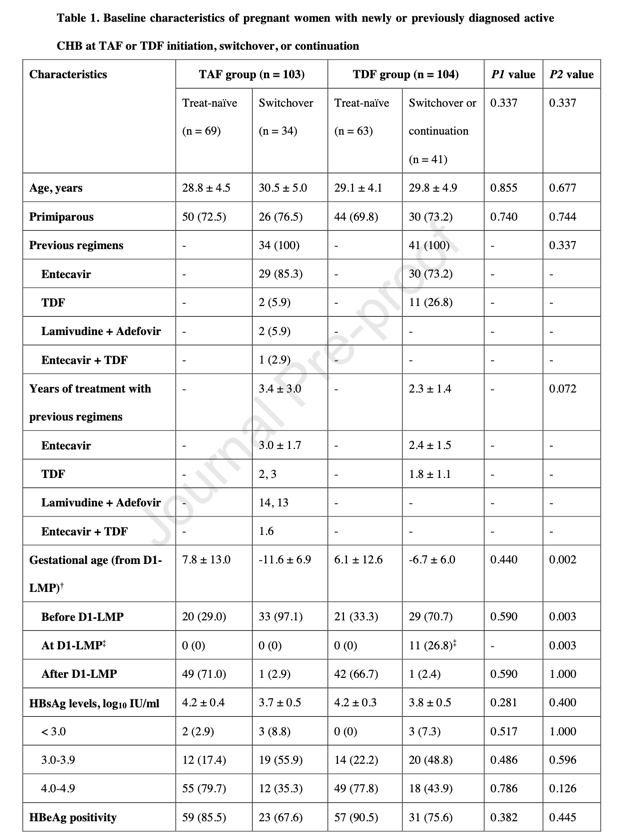
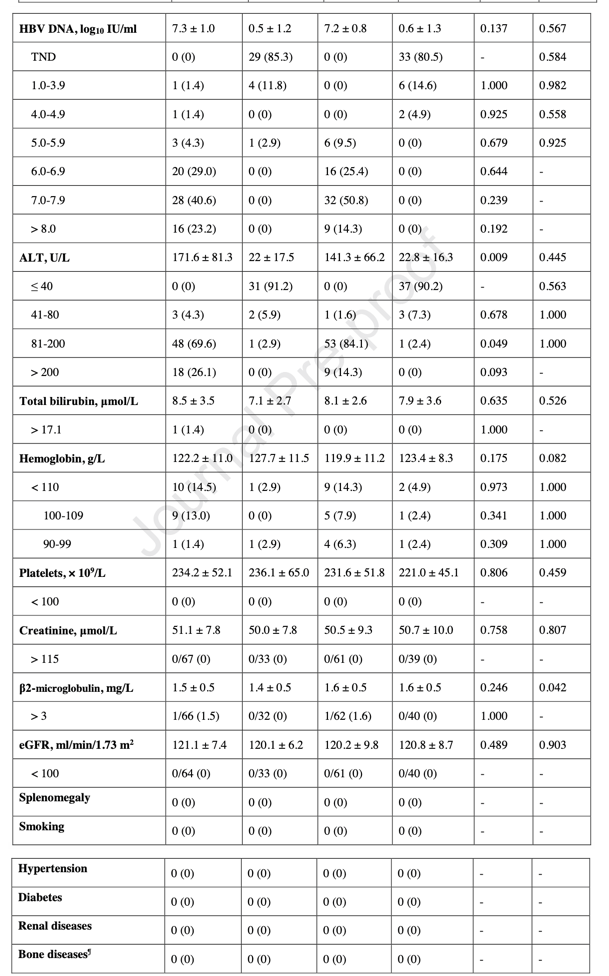
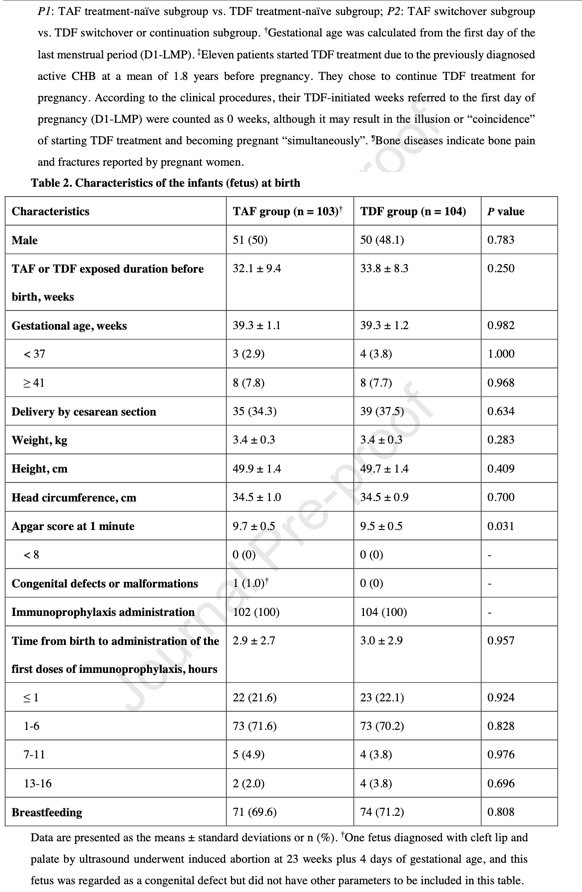
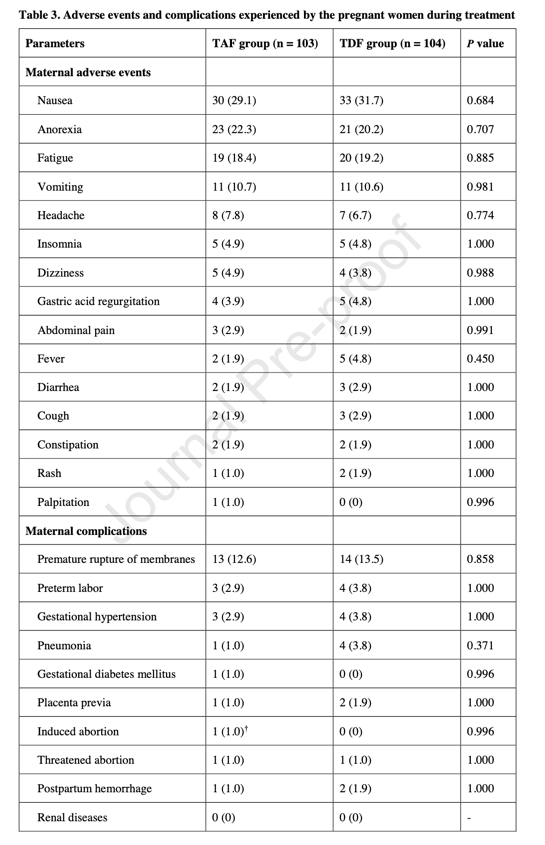
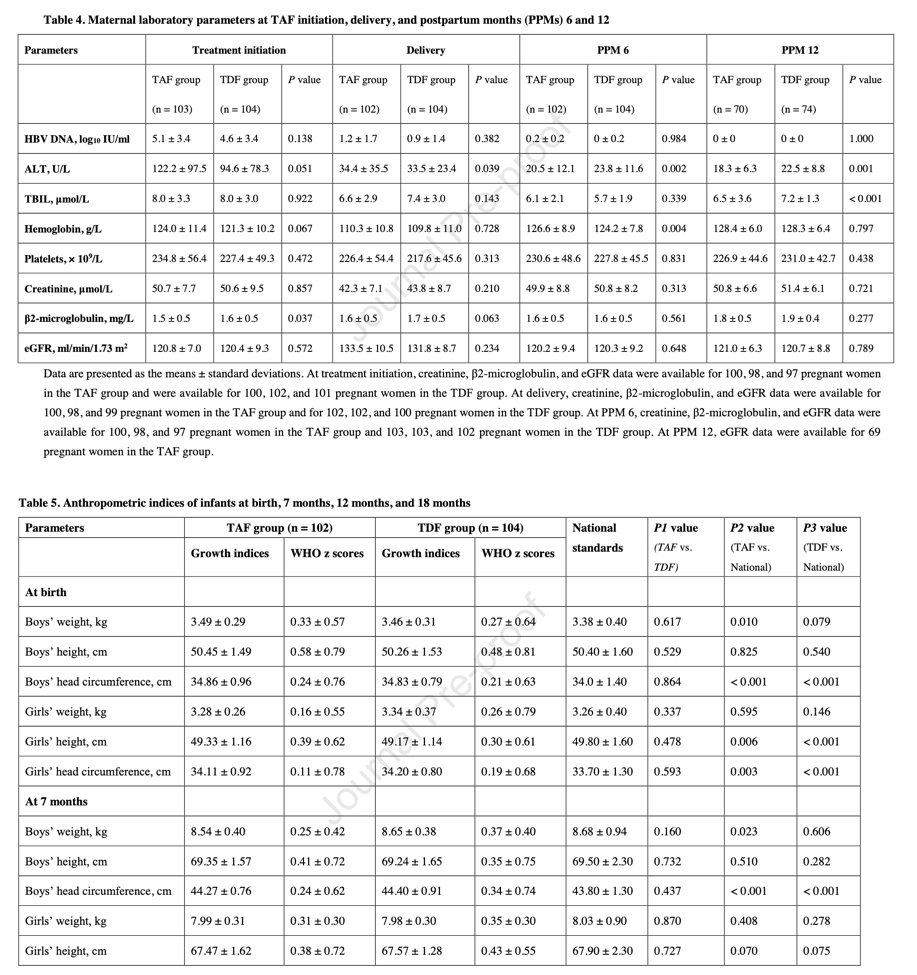
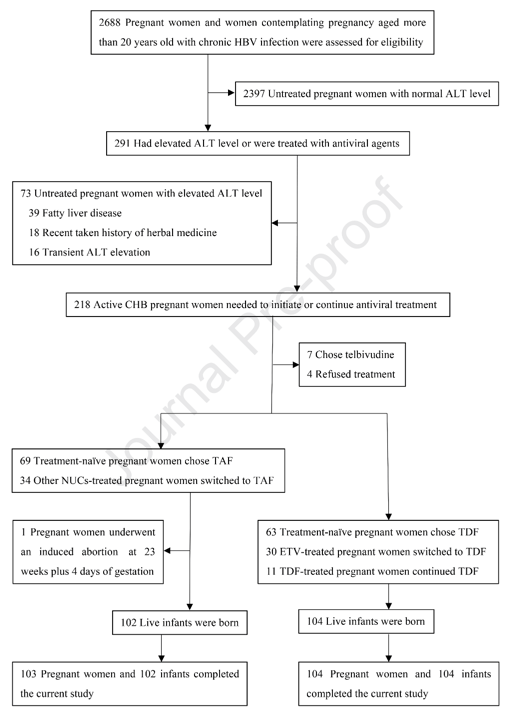
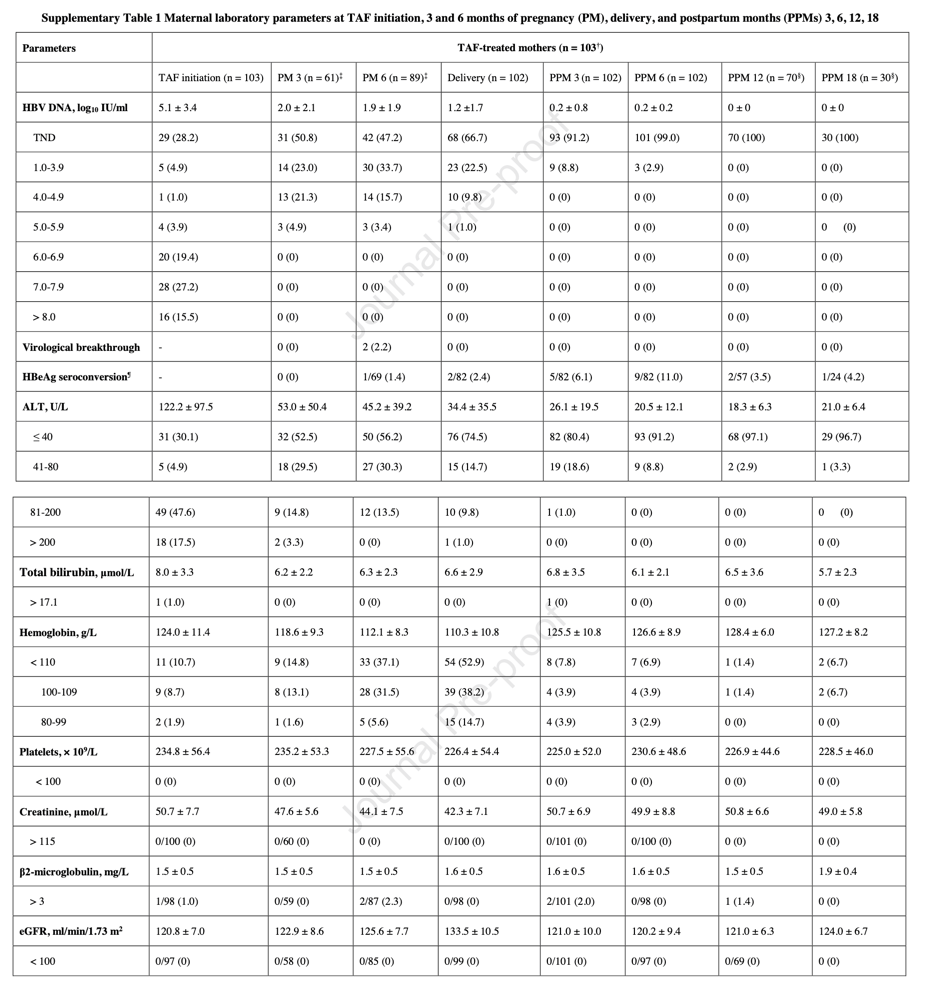
|
| |
|
 |
 |
|
|